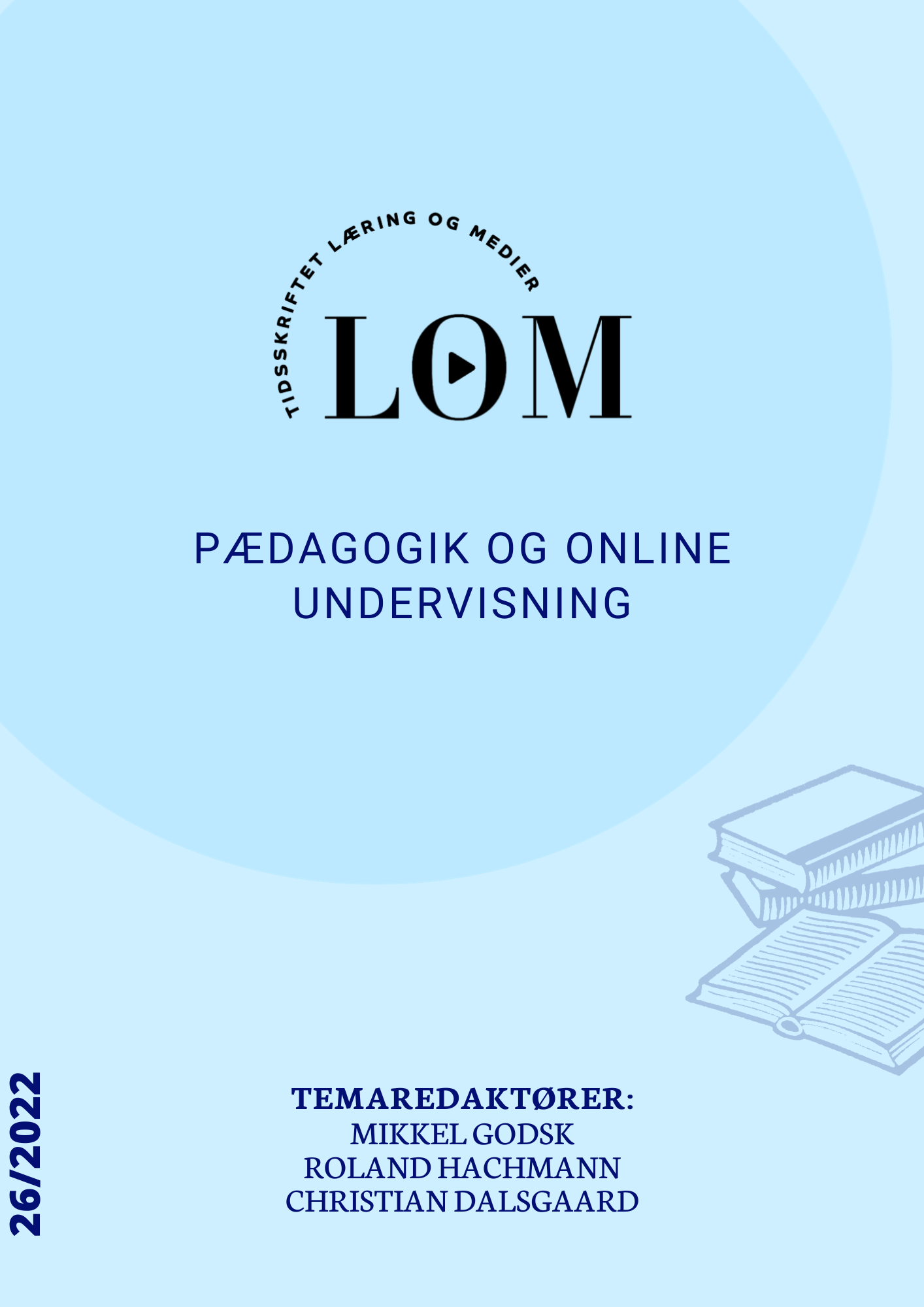Expanding possibilities for student participation in online learning environments for practice-based teaching
DOI:
https://doi.org/10.7146/lom.v15i26.130939Keywords:
Dialogical, online, practice-based, course designAbstract
Developing primarily practice-oriented university courses for an online format challenges
pedagogical ideas about learning communities, participation, and involvement in learning
situations. Here, we report on a didactic design experiment, the aim of which was to design an
online learning environment that supported practice-based learning and in which possibilities for
participation were strengthened and expanded. The experiment was conducted during a 14-week
university course on co-design, in which the teachers designed different digital tools and learning
activities to strengthen the students’ feelings of belonging and community and student-to-student
inspiration. The topics discussed in this paper include how to rethink teaching practices in relation
to online digital learning spaces and—a new practice that emerged from the design experiment—
how to create “in-between spaces.” These spaces can be considered slow spaces that support
reflection and discussion, are less exposed, and can be created within and between lectures.
Downloads
References
Akrich, M. (1992). The description of technical objects. In W. E. Bijker & J. Law (Eds.), Shaping technology/building society. Cambridge, MA: MIT Press.
Akyol, Z., & Garrison, D. R. (2008). The development of a community of inquiry over time in an online course: Understanding the progression and integration of social, cognitive and teaching presence. Journal of Asynchronous Learning Networks, 12, 3–22.
Christiansson, J., Grönvall, E., & Yndigegn, S. L. (2018, August). Teaching participatory design using live projects: critical reflections and lessons learnt. In Proceedings of the 15th Participatory Design Conference: Full Papers-Volume 1 (pp. 1–11).
Cook, V., Warwick, P., Vrikki, M., Major, L., & Wegerif, R. (2019). Developing material-dialogic space in geography learning and teaching: Combining a dialogic pedagogy with the use of a microblogging tool. Thinking Skills and Creativity, 31, 217–231.
Dalsgaard, C., & Ryberg, T. (2022). Digitale læringsrum. Samfundslitteratur.
Dohn, N. B., & Hansen, J. J. (2016). Didaktik, design og digitalisering. Samfundslitteratur.
Ehn, P. (1993). Scandinavian design: On participation and skill. Participatory design: Principles and Practices, 41, 77.
Ellis, R. A., & Goodyear, P. (2016). Models of learning space: Integrating research on space, place and learning in higher education. Review of Education, 4(2), 149–191.
Gehl, J. (2013). Cities for people. Island Press.
Goodyear, P., Carvalho, L., & Yeoman, P. (2021). Activity-centred analysis and design (ACAD): Core purposes, distinctive qualities, and current developments. Educational Technology Research and Development, 69(2), 445–464.
Halse, J., Brandt, E., Clark, B., & Binder, T. (2010). Rehearsing the future. The Danish Design School Press.
Hodges, C., Moore, S., Lockee, B., Trust, T., & Bond, A. (2020). The difference between emergency remote teaching and online learning. EDUCAUSE Review, 3. https://er.educause.edu/articles/2020/3/the-difference-between-emergency-remoteteaching-and-online-learning
Lave, J., & Wenger, E. (2003). Situeret læring. Hans Reitzels Forlag.
Lyngdorf, N. E. R., Bertel, L. B., & Andersen, T. (2021). Evaluering af digitalt understøttet læring på Aalborg Universitet i 2020: Underviser-og studenterperspektiver på universitetets nedlukning som følge af Covid-19.
Ryberg, T. (2020). Studerende frygter, at onlineundervisning er spareøvelse. https://www.akademikerbladet.dk/aktuelt/2020/august/studerende-frygter-at-onlineundervisning-er-spareoevelse.
Simonsen, J., & Robertson, T. (Eds.). (2013). Routledge international handbook of participatory design (Vol. 711). Routledge.
Sfard, A. (1998). On two metaphors for learning and the dangers of choosing just one. Educational Researcher, 27(2), 4–13.
Suchman, L. A. (1987). Plans and situated actions: The problem of human-machine communication. Cambridge University Press.
Tonboe, J. C. (1993). Rummets sociologi: Kritik af teoretiseringen af den materielle omverdens betydning i den sociologiske og den kulturgeografiske tradition. Akademisk Forlag.
Yndigegn, S. L. (2010, November). Extending design encounters with use of social media. In Proceedings of the 22nd Conference of the Computer-Human Interaction Special Interest Group of Australia on Computer-Human Interaction (pp. 356–359).
Downloads
Published
How to Cite
Issue
Section
License
Copyright (c) 2022 Signe Louise Yndigegn, Rikke Gammeltoft Gerwien

This work is licensed under a Creative Commons Attribution-NonCommercial-NoDerivatives 4.0 International License.

Articles published in the Journal of Learning and Media are licensed under a Creative Commons Attribution-NonCommercial-NoDerivatives 3.0 Unported Licens.
Authors retain copyright and grant the journal right of first publication; simultaneously articles are licensend under the Creative Commons Attribution license: Attribution-NonCommercial-NoDerviatives (by-nc-nd). Read about this license at https://creativecommons.org/licenses/by-nc-nd/3.0/
---
At LOM.dk, you will also find articles from the discontinued Journal for the Continuing and Further Education of the Danish Universities (UNEV). Note that special rules apply to UNEV articles:
It is the authors and any other copyright holder who have the copyright of articles published under the auspices of UNEV, and access to the articles is contingent on users acknowledging and complying with the associated legal guidelines:
- Users may download and print one copy of any UNEV publication for private studies or research.
- The redistribution of articles or the use of these for revenue-funded activities or commercial purposes are not allowed.
- It is not allowed to distribute the URLs of UNEV articles.


